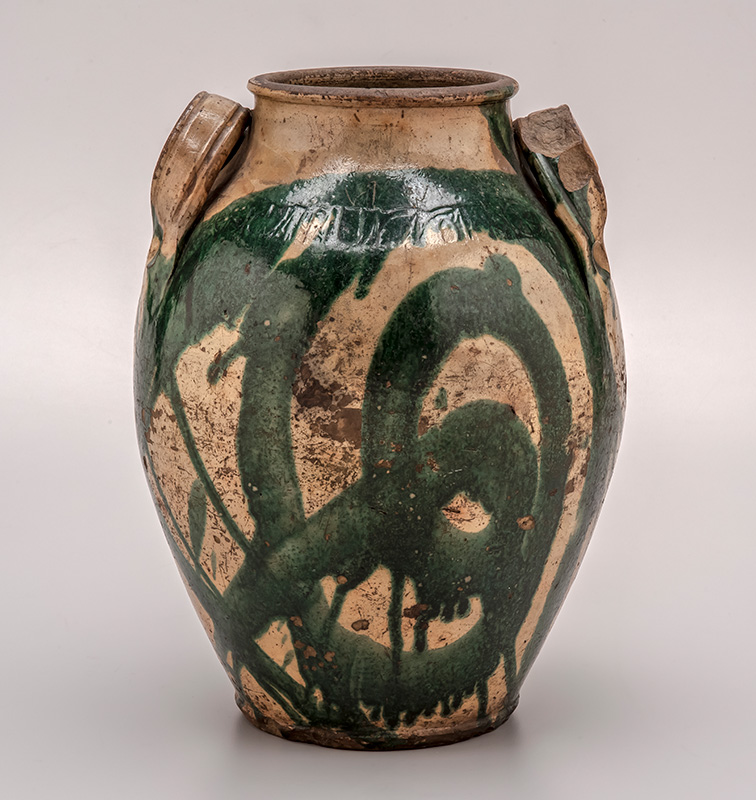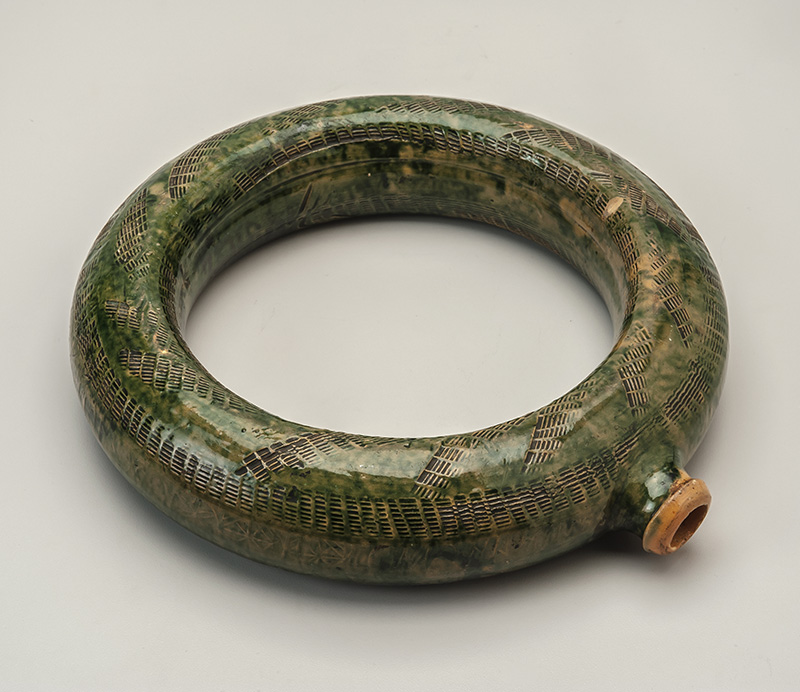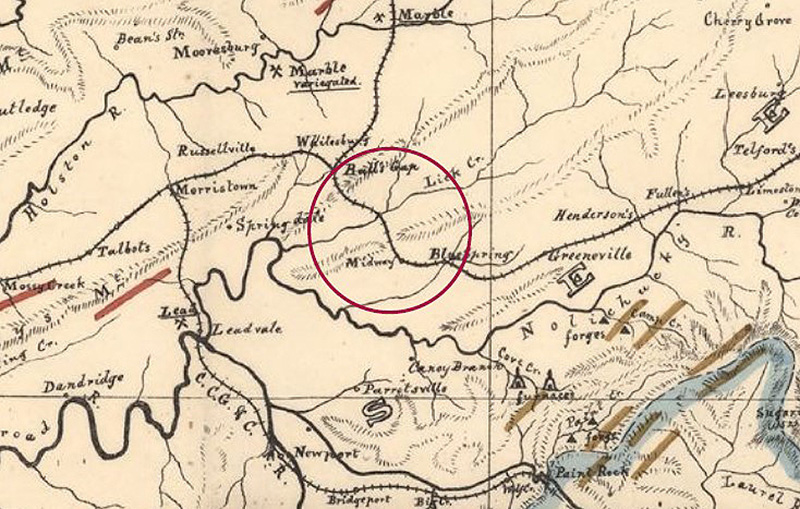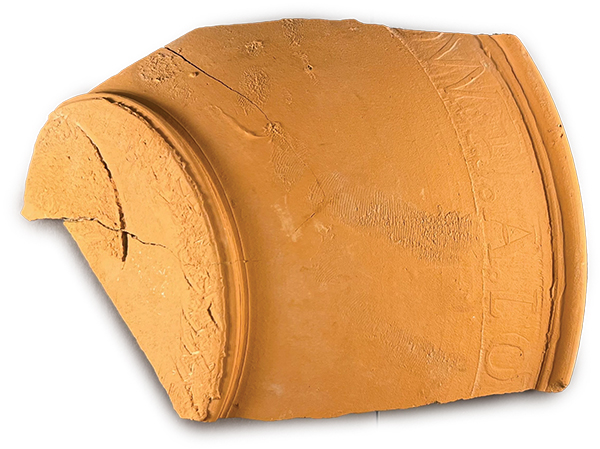Made for Use: The Pottery of C.A. Haun
Click on images to enlarge them and view captions.
by Riley Kate Richards
What is a ceramic pot? This is the deceptively simple question I have returned to throughout the course of my work on earthenware potter Christopher Alexander Haun, who was born in 1821 in Greene County, TN. My Master’s thesis for the University of Delaware’s Winterthur Program in American Material Culture has attempted to answer this question by delving into all aspects of ceramic production in East Tennessee.
Haun produced uniquely decorated utilitarian earthenware pottery until his death in 1861 and is currently a semi-canonical figure in the study of Tennessee decorative arts. With help from a Research Grant provided by the Decorative Arts Trust, my investigation took me around the southeast, from the Museum of Southern Decorative Arts (MESDA) to the Tennessee Division of Archaeology (TDOA). At these locations, I analyzed extant pottery and archaeological sherds dug from a waster depression at Haun’s worksite to better understand the potter’s practice, community, and wares.
Haun’s pottery is often associated with the event that led to his death. On December 11, 1861, Haun was executed by the Confederacy for his participation in a pro-Union bridge burning at Lick Creek in Greene County, TN. This radical action is the dominant story surrounding the interpretation of his pottery. However, in my project, I move beyond this single event and Haun’s political affiliations to focus deeply on the materials and craftsmanship of his jars, ring bottles, crocks, and jugs. My project relies on the material evidence of his wares, including throwing rings, coggle marks, slip application, and clay type, to reveal how Haun’s pottery is an expression of East Tennessee. In doing so, Haun’s pottery becomes the product of not just one man, but also of a community and an environment.
A decorated storage jar held in the William C. and Susan S. Mariner collection at MESDA (figure 1) is one of the most common forms produced by Haun and contains decorative characteristics that exemplify his output. To produce this jar, Haun threw earthenware clay into an approximately 13-inch-tall ovoid shape on a potter’s wheel. The contours of the jar resemble an S-curve, with two lug handles attached to either side of the vessel. While the clay was still wet, Haun marked both the terminals of the handles and the shoulder of the jar with a coggle mark bearing his name (figure 2). Although many East Tennessee potters left their work unsigned, Haun typically identified his wares.
Fired with lead glaze and coated in white slip, this jar also includes swirled copper oxide decoration on the front and back of the vessel. The application of thin copper oxide slip left a random pattern of drips that emphasize the compelling and unique green swirl. This expressive application of glaze both emphasizes Haun’s presence as a maker and illuminates the material quality of the slip. All at once, this jar is utilitarian and decorative, plain and beautiful, typical and atypical, and as it oscillates between these poles, a clear picture of place, maker, and product comes into view.
Beyond these large ovoid storage jars Haun produced other forms of pottery including ring bottles (figure 3) and small jugs (figure 4.) A ring bottle in the MESDA collection is one of the most intriguing of Haun’s extant wares. There are many speculative uses for this type of vessel, but ceramics historian Charles Zug III identified these wares as novelties used primarily to “display the virtuosity of the potter.”1 Ring bottles were difficult to successfully throw, and thus their creation spoke to the skill of the potter. The torus shape would be created by throwing two concentric, raised, circular walls. After raising the walls of both the smaller and larger circular forms, the top edges are brought together, thus forming a hollow tube. The upper side of the torus was then further shaped and formed on the wheel; then as the pot was trimmed the underside would be rounded and shaped to match the upper side.2 The creation of this geometrically complicated form speaks to Haun’s skill at the potter’s wheel and the time and care which he put into producing well-executed vessels. A customer’s ability to own such a novelty also demonstrated their wealth.
Pottery in East Tennessee corresponded with the largest industry in the region: agriculture. Farmers, including Haun and his family, grew crops mainly for the sustenance of their own families and neighbors. The subsistence of the family farm depended on the opportunity to preserve food for the winter, which often took place in jars like those made by Haun. Malinda Russell, a free woman of color from Greene County, provides a recipe in an 1866 cookbook that converted the fresh produce available for harvest in late summer to be eaten the following spring. The recipe is as follows:
Chow Chow: One peck green tomatoes, half-a-dozen peppers, one dozen onions, grated horse-radish; chop and scald in salt and water, drain in a sieve, pour into jars and pour spiced vinegar over it.3
Local ceramics would have been the main storage vessel available to Haun’s community in mid-19th century Greene County. Haun and the potters who worked with and around him responded to this demand, supplementing their farming with part-time potting in the off-season.
To throw and glaze the containers needed to preserve and process food, Haun’s first priority was gathering his raw material. Clay serves as the potter’s essential ingredient: its location, quality, color, and plasticity all strongly affect the end product. Haun and his contemporaries likely dug their earthenware clay from local sections of land that had been cut away by rivers or streams to reveal clay layered beneath topsoil. The raw material was carted back to their worksite for processing. The clays available to Haun were entirely dependent upon his location. The production of earthenware relied on the formation of the Appalachian Mountains and their surrounding foothills 500 million years prior to Haun’s lifetime. Considering East Tennessee’s geologic make-up, ceramics reveal their intimate connection to the earth, a connection equally important to that of the maker.
A location-specific geologic understanding of pottery is expanded upon in my thesis, and complicates the idea of Haun as a singular maker. Although museums and auction houses list Haun’s pots solely under the name “C.A. Haun,” a community of potters surrounded these objects. This community is revealed through an investigation of Haun’s known kiln site, which was close to Lick Creek in Greene County (figure 5). Written archaeological evidence points to the identity of those he worked alongside at the site, including his brother Lewis, J.A. Lowe (figure 6), William Hinshaw, and others, all of whom operated the same kiln and likely shared equipment.4 In order to produce a usable ceramic vessel, clay was processed, pottery thrown, glaze milled, and pots fired. The wood-fired kilns used in mid-19th century East Tennessee needed their fireboxes constantly fed and stoked in order to maintain temperature. This was therefore an activity completed by more than one potter. Firing, alongside all the other material processes completed at the site, should be considered as an effort undertaken communally by this group.
The 26,736 sherds uncovered by the TDOA tell us a bit more about the potting practices of these men. An abundance of these sherds are linked to J.A. Lowe, who used a name-bearing coggle mark (figure 7). The sheer quantity of sherds with Lowe’s name speaks to his skill as a novice potter.5 In contrast, the lack of sherds attributed to Haun may demonstrate his relatively superior skills, and perhaps situates the younger Lowe as a student or informal apprentice of Haun’s. Therefore, Haun sometimes marks his wares with the suffix “&Co.” and worked within a system of craft knowledge, where skills and techniques were passed to others and laborious tasks were shared among a group of craftspeople with varying abilities.
Haun complemented the clay bodies he created with eye-catching applications of glaze. One may be quick to celebrate these pots within a modern language of design, or pair them with the tragic story of Haun’s death, but my research has led me to look at these pots and their visual aspects as useful through and through. While utilitarian pots may seem incompatible with this type of design, material evidence shows that these wares underwent heavy and sustained use. The application of bright, abstract decorations, which varied from pot to pot, may have served as a handy tool for owners to identify which jars had the peaches and which ones had the chow chow, as they sat beside one another in storage for long periods of time.
Haun’s pots are not just reflections of his life as a farmer and artisan, they are complex expressions of geography, geology, and ecology. As such, clay, lead, copper, water, fire, hands, wood, migration, climate, and culture all come together to produce something so deceptively simple. Sitting on a plinth in a museum or a sideboard in a collector’s house, these ceramics are quiet, and their complexities are hidden. I argue that by understanding the expressions of place in Haun’s ceramic pots, a profoundly meaningful story of life in East Tennessee can be told, one that rises from deep in the earth to the homes of people.
- Charles G. Zug, Turners and Burners: The Folk Potters of North Carolina (Chapel Hill, NC: The University of North Carolina Press, 1990), 375.
- Robert Hunter and Michelle Erickson, “Making a Moravian Faience Ring Bottle,” in Ceramics in America (Milwaukee, WI: The Chipstone Foundation, 2009).
- Malinda Russell, A Domestic Cook Book: Containing a Careful Selection of Useful Receipts for the Kitchen (Paw Paw, MI: T.O. Ward, 1866), 19.
- Samuel D. Smith and Stephen T. Rogers, Tennessee Potteries, Pots, and Potters, 1790s to 1950 (Nashville, TN: Division of Archaeology, Tennessee Department of Conservation, 2011), 138.
- Smith and Rogers, 1000. Rim sherds with Lowe’s name, in conjunction with the presence of thick sherds from the bases of pots, leads archaeologists to discern that Lowe had less experience than Haun, and his pots therefore did not survive firing with the same frequency.
Riley Kate Richards recently graduated as a Lois F. McNeil Fellow in the University of Delaware’s Winterthur Program in American Material Culture. She is currently serving as the Tiffany & Co. Foundation Intern in the American Decorative Arts at The Met.
A print version of this article was published in The Magazine of the Decorative Arts Trust, one of our most popular member benefits. Join today!







